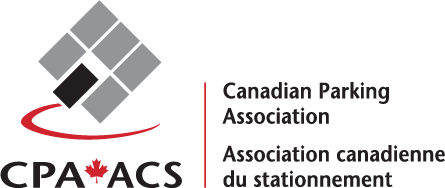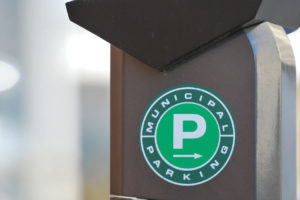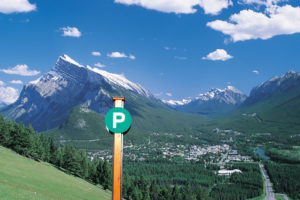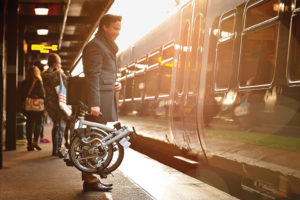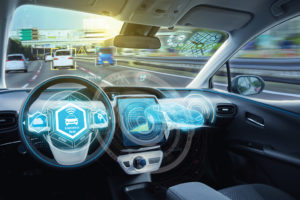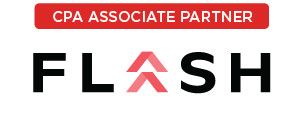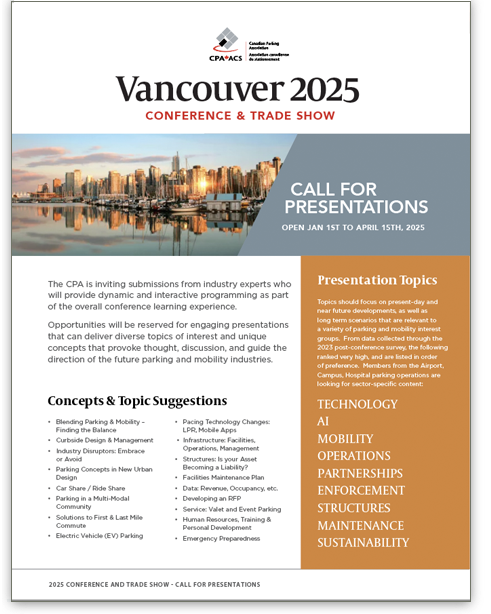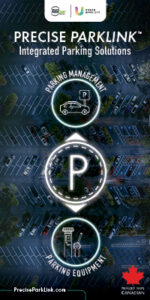Torontonians wanted an app for parking — and they got it
By Stacy Sneed
One of the fastest growing cities in North America, Toronto is a hub for the design, finance, science and media industries. The city is also known for its tech savviness and app usage. In 2016, the latest report by Yahoo Canada! shared that Canadian app use grew by an average rate of 74 percent, far exceeding the global average of 11 percent. In fact, the number of Canadian devices exceeds the estimated number of Canadians by more than 2 million. What this signifies is that people in Toronto enjoy the ease and convenience apps add to their lives. When citizens become accustomed to the advantages that apps provide, they want to have access in every part of their lives … including interactions with their local government.
As this growing metropolitan area reached over 6 million residents in 2014, it faced increased congestion and traffic. Finding parking in Toronto became a hassle for drivers, and parking payment options were limited. Drivers either had to have cash available for meters or use their credit cards at a pay station. The Toronto Parking Authority (TPA) realized that point of frustration for drivers, and saw an opportunity to offer a better way to pay for parking. TPA issued a request for proposal (RFP) for mobile pay providers in 2014 in an effort to improve the overall parking experience around the city.
“The choice to go with a mobile app was heavily driven by our customers. We also wanted to provide an operational cost savings with it,” said Ian Maher, TPA’s vice president of strategic planning and I.T.
TPA sought a solution to implement technology and make local trips faster and easier. In order to achieve that, the…
An interview with Shawn Skrine
By gtechna
In advance of this year’s Canadian Parking Association Conference held in Banff, Alberta, Banff’s Shawn Skrine sat down with gtechna, a Montreal-based eCitation and parking software company, for an interview that revealed some interesting points about what exactly makes a city “smart”.
Banff is a resort town located inside a national park, which means it has a small number of permanent residents and a seasonal population that fluctuates widely. Embracing cutting-edge parking technology has allowed Banff to easily accommodate the annual influx of tourist traffic; a great reminder that being a smart city is more about innovation than population!
Can you describe for us what parking is like in Banff?
We have five full time enforcement officers and in the summer, two to three seasonal officers. Our officers use two vehicles and two bikes to patrol roughly 2,000 spaces that we have downtown.
We have several surface lots, one four-story parking structure, and a good deal of street parking. All of our parking is time-limited, but free.
How does Banff’s high volume of tourists affect the parking situation?
To be honest with you, it’s more of the locals that were affected when we started implementing time-limit parking than it was the tourists, because tourists seem to look for signs.
We started time-limiting the parking to change behavior, which seems to have happened. Now after three years, there’s been about a 30% increase in time-limit compliance. The number of tickets issued for time-limit offences has been reduced and downtown parking turnover has improved, which is what we wanted.
What are the rules you use for time-limited parking?
It varies. Our zones range from 15-minute limits all the way to nine-hour limits. Streets usually have either two-hour or 15-minute limits, parking lots are all three hours, the parking structure has two-hour and eight-hour spaces, and there are…
By Danielle Desjardins
Thanks to the advancement of mobile computing, embattled city drivers cruising for a parking spot in our cities asphalt jungles are being presented with numerous new tools.
These tools come from a new wave of start-ups catering to parking services. These apps can book parking spaces before the driver leaves, pay for it online and even, in some instances, locate available parking spaces.
Take Parkifi, for instance. The Denver company has put together a mix of way-finding, data analytics and Internet of Things (IoT) technologies that uses hardware embedded in parking spots to alert drivers to open parking spaces (the feature is only available in Denver for now).1 Last spring the app added a way for users to pay for parking from their phone2.
Parkifi (https://www.parkifi.com/) presents itself to parking operators as an optimizer of their portfolios through a better exploitation of inventory utilization, prediction of future occupancy, optimization of pricing to match supply and demand, among other things.
What they offer parking operators is “efficient visibility and marketing tool by providing a better “parking experience for drivers, increasing satisfaction and repeat business”.
Or, as Parkman, another parking tools developer based in Finland, puts it: “customers are using phones to navigate to destinations. Make sure they navigate to your garage.”3
Finding available parking spaces in real-time is no magic act. For Parkopedia, a nine-year-old London company, it involves big data. The company relies on a trove of parking data it amassed since being established in 2007: starting with humans doing the job of surveying and taking pictures of parking garages, evolving to dynamic data sets provided via APIs from partners to GPS and traffic flow information from car manufacturers, accumulating along the way petabytes of parking information in the cloud. With this information, the predictive algorithms the Parkopedia team of four PhDs developed…
By Chelsea Webster
Let’s start the first mile of this journey by setting a goal for reading this article: learning what first mile and last mile means in relation to transportation, and finding ways for the parking industry to embrace (and maybe even capitalize) on this growing urban challenge.
The Rise of Public Transit
If you live in a city, you likely understand that public transit is an important part of city life. As more of the world’s population moves into cities, and cities aren’t able to accommodate the demand for individual cars and parking, transit will continue to grow in importance. There are lots of articles already touting that the personal vehicle is falling as king of transportation. As this process happens, it will be even more critical to make taking alternate methods of transportation as easy as possible.
If you’ve ever tried to take public transportation, you’re likely aware of a big setback inherent in any transit system: it doesn’t come right to your door.
So, if people aren’t willing to walk to the “nearest” transit stop, but still want to take the train or subway or express bus, how do they get to that transit stop? The process is called first mile (getting from your house or starting point to the transit stop) and last mile (getting from where transit lets you off to your actual destination) commuting.
We Love Our Cars
Thanks to the automobile revolution, we’ve seen the personal vehicle have a massive economic impact. Highways were built, automotive factories churned out vehicles of all sorts, and a whole new parking industry sprang up – all of which created hundreds of thousands of jobs in Canada and the US. With the ability for the average person to own a vehicle, people had the freedom to live and travel to places previously…
By Danielle Desjardins
We are on the brink of a revolution, a revolution that will profoundly affect society, change the way cities look and function and fundamentally transform how people and goods move.
It’s been dubbed the “driverless revolution” and it will be brought about by the advent of autonomous cars (AV), cars that drive themselves with little or no human intervention. In addition to their effect on modes of transport, AVs are poised to disrupt many industries: fast food, real estate, hotels, airlines — large industries that will have to shift their strategies in the wake of driverless cars.
The biggest disruption could be on parking. Among other innovations the revolution will bring, we will see AV fleets moving continuously between the various places they are needed, rendering the need for close and convenient parking spaces much less necessary.
Ready for the driverless revolution?
In the last issue, we discussed the potentially impending driverless revolution and the impact it could have on the parking industry1. In the envisioned driverless society, fully automated vehicles (AVs) would drop their passengers at their destination, go home to park or return in the transportation network while awaiting their next ride and the parking industry would be massively disrupted.
To some, the driverless revolution is already be upon us and our roads will be overtaken by robocars within the next five to ten years. Is this belief shared by the people involved in parking and are they getting ready for it?
In need of a crystal ball
Although all those interviewed for this article believe AVs will eventually rule our roads, some also believe that the revolution will be a long time coming.
“I don’t see it happening in my lifetime”, states Professor Michel Lejeune, who teaches sociology of technology at École Polytechnique in Montréal. The technology may be outstanding and almost…
By Danielle Desjardins
We are on the brink of a revolution, a revolution that will profoundly affect society, change the way cities look and function and fundamentally transform how people and goods move.
It’s been dubbed the “driverless revolution” and it will be brought about by the advent of autonomous vehicles (AV), cars that drive themselves with little or no human intervention. In addition to their effect on modes of transport, AVs are poised to disrupt many industries: transit, insurance, all industries that currently need drivers, driving support services, and the technology sector — large industries that will have to shift their strategies in the wake of driverless cars.
One major disruption could be on parking. Among other innovations, the revolution will bring, we will see AV fleets moving continuously between the various places they are needed, rendering the need for close and convenient parking spaces much less necessary.
As Alain L. Kornhauser of Princeton University told the online magazine Curbed, “Having parking wedded or close to where people spend time, that’s going to be a thing of the past. If I go to a football game, my car doesn’t need to stay with me. If I’m at the office, it doesn’t need to be there. The current shopping centre with the sea of parking around it, that’s dead.”1
How soon will that revolution begin? A number of car manufacturers predict that AVs will be launched about 2020, with many suppliers focusing first on driverless taxis. RethinkX, a think tank on technology-driven disruption, believes that by 2030 “95% of U.S. passenger miles traveled will be served by autonomous electric vehicles.” 2 Others foresee a clear majority of urbanites not even needing to own cars by 2040, because they’ll subscribe to some form of on-demand self-driving car service.3 McKinsey & Company believe that once technological…
By Giovani Forner, Director of Research and Development
Brazil is widely known for its amazing natural beauties and top soccer players, but now a group of engineers from Porto Alegre wants to place the country as a leader also in the automated parking field. Pioneers in providing innovative products, Engeltec developed a new, complete solution for Valet Parking that is shaking the national market, and now they prepare to cross borders, starting with Canada.
Living in a country similar to Canada with continental dimensions, Brazilians love their cars, even though they have to pay among the highest prices in the world to drive them (due, in large part, to high taxes and low market competition). The National Department of Vehicles in Brazil estimates 93,305,422 are currently running through their roads, a number almost three times higher than in Canada. Turning, as a matter of fact, parking into a valuable and competitive business in the South American country.
And Engeltec’s solution is unique to the whole world. It automates the manual steps of bridging all information into one platform. The valet operator needs less people to do the same function, while receiving fast and reliable information from the software. The result is nothing but profit.
The challenge for the Brazilian company, though, was to automate the maximum steps of check-in with no drivers’ interaction. This means the user experience will be as fast as possible, allowing clients to do more with the same amount of human resources from the valet company. Engeltec engineers spent last year perfecting their prototype and now the first model is already in functioning.
One software, three hardwares
The solution combines a software with three simple hardware devices: an OCR camera, a mini Smart Cube and a Pinpark device.
Here’s how it works
The OCR camera recognizes the license plate. Placed above the car, the…
By Chelsea Webster
Let’s start out with a quick poll:
What model year is your vehicle?
Okay so there was only one respondent, but I think it’s safe to say that with new car sales of 3.8 million in Canada1 and 34.5 million in the US in the last 2 years2, there are a LOT of vehicles on our roads that are a 2014 model year or newer.
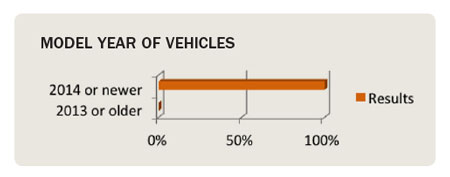
Why does this matter?
Consider this quick rundown of the major car advances to land in our vehicles.
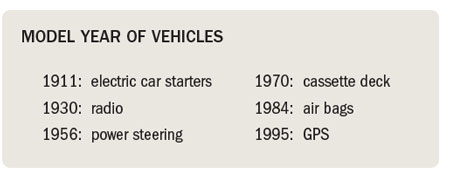
So, now that internet connectivity is showing up in cars, you can see how such a big change is cause for discussion. We’re basically taking the Internet of Things (if this term isn’t familiar, it’s the concept that everything is now connected on the internet – from your home thermostat to your heart rate monitor to the security camera on the street4) and applying it to vehicles. This concept of the fully connected and communicative vehicle is called the Internet of Vehicles (or IoV as we’ll refer to it).
IoV Fundamentals
Overall, the IoV is a massive network of connection points to the internet which are in constant communication. It’s meant to guide and supervise vehicles while providing abundant multimedia and mobile Internet application services. There are several components to understand within IoV, so let’s go over a few details.
Why would we want this? There are four main benefits of IoV5: safety (if you know the car in front of you is stopping, you can brake early); environmental damage mitigation (use less horsepower to reduce emissions); energy conservation (maximize efficiency in gas consumption); and intelligent communication (avoid a traffic jam, construction, or pay for parking).
Who is the car communicating with? There are several important groups…
By Chelsea Webster
Parking is an easy first step for a municipality to take towards becoming a smart city because the technology already exists, and it can be tested and proven with minimal resources.
Key points
- A Smart City is defined by sensors that collect information and relay it to a hub, which recommends actions based on data analysis. Smart parking is applying this concept to parking.
- Citizen and government engagement and interaction is critical to the success and long term viability of the smart city concepts.
- Smart parking is a subset of the smart city concept that’s easily implemented; pros and cons exist, however the net impact is positive.
- Many other technologies (like autonomous vehicles) are impacting the adoption of smart parking and often creating more questions than answers.
Action: Three actionable suggestions can be found at the end of the article if you are interested in implementing smart parking in your municipality.
What is a Smart City?
The term “Smart City” has been making the rounds lately, and I’d venture a guess you’ve heard it once or twice by now (or perhaps you live and work outside the realm of this concept, which is fine too). But for everyone who has heard it, as much as for those who haven’t, what does it actually mean? For all the hype, it still isn’t listed on Dictionary.com or Merriam-Webster. A smart city is a broad concept, with no precedent, and as of yet, there aren’t set standards as to what defines a city as smart. Oh. Now what?
There are a lot of working pieces involved in the smart city concept, but let’s break it down into two key components: technology (physical and virtual requirements) and data (collection and application).
1. Technology
This is the network of sensors, cameras, and other devices that get built into the…
What Lies Ahead for the Canadian Parking Industry?
It’s always fun to speculate about what the future holds. When it comes to parking, it’s particularly enjoyable because the industry is progressing so rapidly. Change has always been a hallmark of the industry as over the years parking designers, planners, and technology developers have worked to keep up with the evolution of the car.
The last few years have been among the most exciting we’ve ever experienced. Recent years have brought the groundbreaking planning innovations of Donald Shoup and his many likeminded colleagues. They’ve also brought a host of design and maintenance innovations that have made parking facilities more useful and durable than ever before. And of course they’ve brought an incredible array of new parking technologies that have transformed the parking experience for drivers while making parking more manageable and cost-effective than ever.
But as exciting as the past few years have been, there are many more exciting parking developments right around the corner. From design, to planning, to technology, we are on the cusp of an extraordinary parking age.
It’s like that song from the eighties said: The future’s so bright, we gotta wear shades.
Planning for the Future
Planning is one of the most exciting features of the parking industry today. Urban planning has undergone extraordinary change in recent years, and parking planning is keeping pace. Some of the most exciting urban planning approaches, such as New Urbanism and Complete Streets, revolve around making cities more pedestrian-friendly and reducing vehicle congestion on the streets. Parking planning plays a vital role in the success of each.
One of the most important elements of parking planning is to use parking resources to influence driver behavior. By strategically placing parking resources, cities and towns can encourage drivers to park and make the transition from driver to pedestrian…

